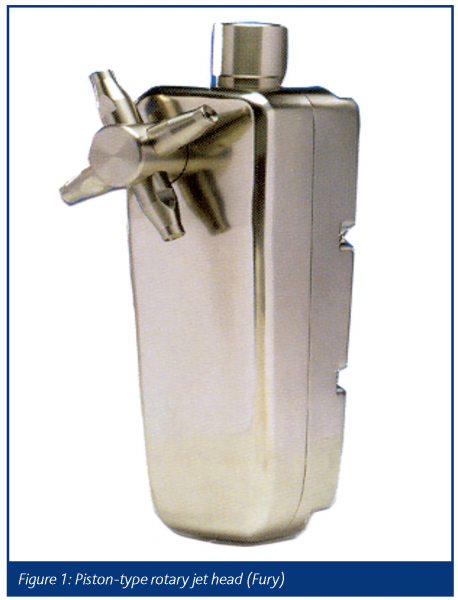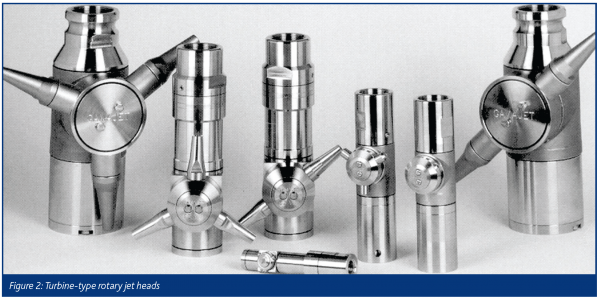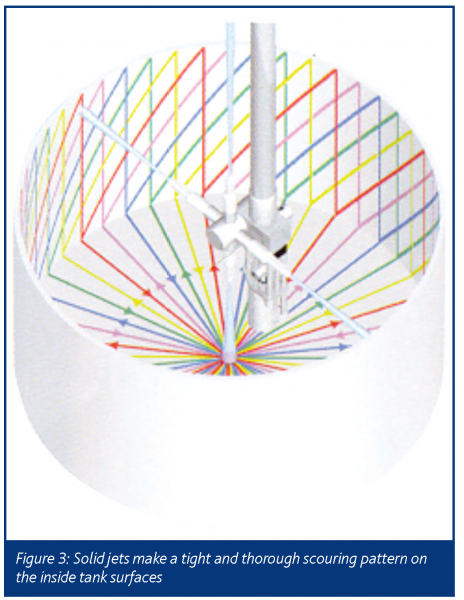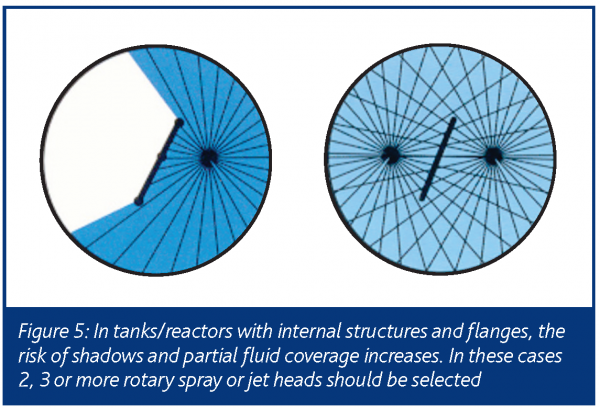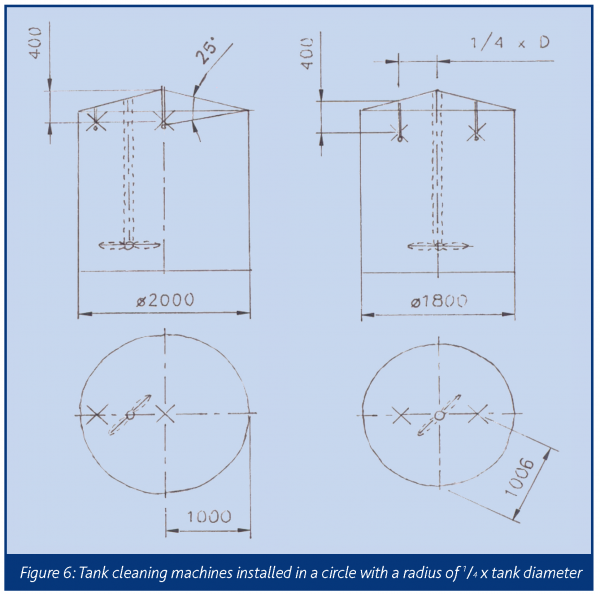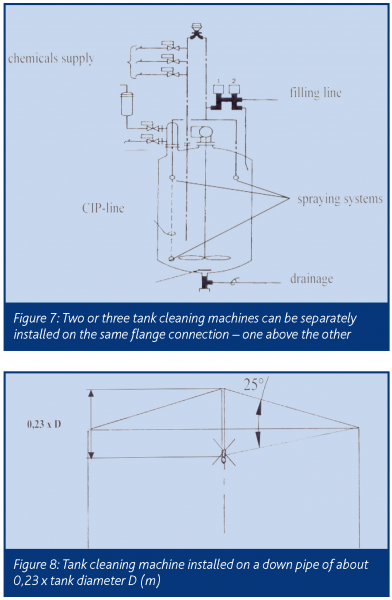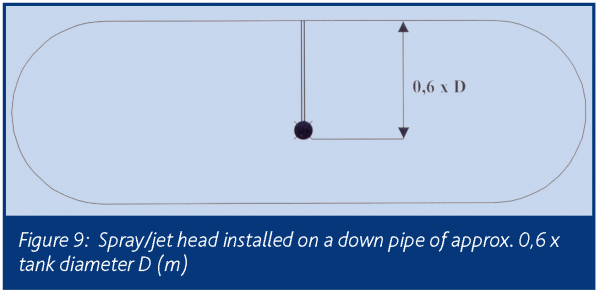Rotary jet heads for perfect tank cleaning
- Like
- Digg
- Del
- Tumblr
- VKontakte
- Buffer
- Love This
- Odnoklassniki
- Meneame
- Blogger
- Amazon
- Yahoo Mail
- Gmail
- AOL
- Newsvine
- HackerNews
- Evernote
- MySpace
- Mail.ru
- Viadeo
- Line
- Comments
- Yummly
- SMS
- Viber
- Telegram
- Subscribe
- Skype
- Facebook Messenger
- Kakao
- LiveJournal
- Yammer
- Edgar
- Fintel
- Mix
- Instapaper
- Copy Link
Posted: 21 November 2005 | Frank Moerman, Chairman, EHEDG Belgium | No comments yet
In part 2 of his article examining the selection of spraying systems, Frank Moerman gives an overview of the different rotary jet heads offered for sale on the world market. The article finishes with details on the positioning of the tank cleaning machine in the reactor/tank.
Rotary jet heads are fluid driven (turbine-type or piston-type) or motor-driven (electric or pneumatic) tank washing nozzles. They are composed of a stator, a drive mechanism and a rotary washing head with between one and four or more nozzles. At high pressures, solid streams of 7-30 m in stationary conditions and 4-20 m at rotation are obtained. Turbine-type rotary jet heads can operate at pressures of 3-250 bar, while piston-type rotary jet heads operate at 3-12 bar. Rotary jet heads are made of stainless steel 316 or 316L, operating at temperatures of -30°C to +120°C (with a maximum of 140°C).
In part 2 of his article examining the selection of spraying systems, Frank Moerman gives an overview of the different rotary jet heads offered for sale on the world market. The article finishes with details on the positioning of the tank cleaning machine in the reactor/tank. Rotary jet heads are fluid driven (turbine-type or piston-type) or motor-driven (electric or pneumatic) tank washing nozzles. They are composed of a stator, a drive mechanism and a rotary washing head with between one and four or more nozzles. At high pressures, solid streams of 7-30 m in stationary conditions and 4-20 m at rotation are obtained. Turbine-type rotary jet heads can operate at pressures of 3-250 bar, while piston-type rotary jet heads operate at 3-12 bar. Rotary jet heads are made of stainless steel 316 or 316L, operating at temperatures of -30°C to +120°C (with a maximum of 140°C).
In part 2 of his article examining the selection of spraying systems, Frank Moerman gives an overview of the different rotary jet heads offered for sale on the world market. The article finishes with details on the positioning of the tank cleaning machine in the reactor/tank.
Rotary jet heads are fluid driven (turbine-type or piston-type) or motor-driven (electric or pneumatic) tank washing nozzles. They are composed of a stator, a drive mechanism and a rotary washing head with between one and four or more nozzles. At high pressures, solid streams of 7-30 m in stationary conditions and 4-20 m at rotation are obtained. Turbine-type rotary jet heads can operate at pressures of 3-250 bar, while piston-type rotary jet heads operate at 3-12 bar. Rotary jet heads are made of stainless steel 316 or 316L, operating at temperatures of -30°C to +120°C (with a maximum of 140°C).
Piston-type rotary jet head
Unique among jetting washers, the FURY (Breconcherry) is driven by a low speed piston, powered by only a small fraction of the cleaning and rinsing liquid (about 4%). Approximately 95% of the cleaning and rinsing fluid passes directly to the nozzles, maximizing jet impingement. The remaining 1% serves to lubricate the drive mechanism and to remove soil. The risk of fouling the piston chamber is minimised by means of a deflector mechanism. FURYs are completely constructed in stainless steel 316/316L. Their greatest advantage is minimal wear owing to the absence of bearings and gears. Moreover, they are energetically highly efficient compared with turbine-type rotary jet heads.
The piston-type rotary jet heads operate at pressures of 3-12 bar (with an optimum of 4-9 bar). This results in an effective cleaning and wetting radius of respectively 5-13,5 m and 7-17,5 m. The flow rates fall within a range of 50-740 l/min. FURYs operate at a temperature of 95°C, with a maximum of 140°C.
Turbine-type rotary jet head
Rotor-type (also named turbine-type) jet heads (Gamajet, Toftejorg, Spraying Systems) are composed of a stator; a rotor or turbine; a gearbox and a rotary washing head with nozzles. This rotary tank washing machine revolves 360° in both the horizontal and vertical planes, with synchronised solid jets providing a tight and thorough scouring pattern on the inside tank surfaces. The horizontal and vertical rotation patterns are interlocked and controlled by gears, not by any reaction forces. The wash fluid enters at the inlet collar where it encounters and spins turbine blades. The turbine blades are attached to the top of the rotor shaft, while the bottom of this shaft is connected to a planetary gearhead which then turns the body in the horizontal plane and the nozzles in the vertical plane. Most commercial turbine-type jet heads are provided with a nozzle to continuously clean the exterior of the tank cleaning machine. They are made of stainless steel 316/316 L, while rotor shafts and bearings are covered by a ceramic, carbide or protective coating. The dynamic seals are made of PTFE, PEEK, EPDM, PVDF, Tefzel®, Viton®, nitrile or Kalrez®. O-rings (preferable made of the same materials) must give protection against leakage, abrasion damage and deposit build-up. All gears are manufactured with selected stainless steel alloys that are covered with a protective coating. Gearboxes should ideally be lubricated by cleaning solution, although other models are lubricated with food-grade oil. With lubrication by cleaning solution, the flow aids in cooling and removing solid particles from between the bearings.
Turbine-type jet heads operate at pressures of 1,5 to 45 bar, resulting in an effective cleaning and wetting radius of 4-15 m and 7-29 m, respectively. Turbine-type jet heads are applicable at temperatures of 95°C, with a maximum of 140°C.
Motor driven rotary jet heads
Motor driven rotary jet heads are controlled by air or electric motors. For high-impact cleaning (pressures up to 300 bar), they rotate the spray head in all directions. The jet head is mounted on a shaft and can be positioned through a small tank opening by means of a flange, screw thread or a rubber bunghole mounting. There are manual systems available that are excellent in the cleaning of barrels, reactors and tank containers (500-5000 l).
Cyberjet
A robotically driven tank washing machine, named the ‘Cyberjet’, has been developed at the Dutch Kramers Laboratory for Physical Technology by Dr. F. Verbeek. The ‘Cyberjet’ is a programmable tank washing robot that controls the jet of cleaning fluid (impingement point and fluid intensity) in a sophisticated way, to obtain an optimum cleaning performance that is adapted to the shape of the tank. The programming is such that the trajectory of the jet’s impingement point covers the entire inner tank surface. The ‘Cyberjet’ consists of a stainless steel rotary head with a rotatable nozzle, placed at a fixed location in the tank by means of a (retractable) supply pipe. The movement of the head is entirely driven outside of the tank by means of two stepping motors. Inside the tank there are no electrical components. To control the rotation of the washing head, a polar-coordinate model is used to direct the spraying action. Moreover, the fluid pattern and correct fluid intensity are adjusted to the shape of the tank and adapted to a maximum to avoid recontamination with residue streaming down from higher places. Due to the ‘spot washing’, difficult-to-clean areas (e.g. ‘dead legs’) can be easily and thoroughly cleaned. The ‘Cyberjet’ combines this thorough cleaning with great economy, resulting in spectacular savings in time, water, energy, cleaning agents, storage tanks (CIP-tanks) and waste water. The consequence is a substantial reduction in operational costs of the washing process. The ‘Cyberjet’ is excellent in the cleaning of medium sized tanks. The automated machine is also economically compatible with recently developed cleaning techniques, such as the use of cleaning foams, gels, air and nitrogen-gas.
Number and placement of tank cleaning systems
The number of static/rotary spray/jet heads is determined by the tank dimensions (diameter, height, length); the tank shape (cilindrical, dome/cone, squared, etc.); the presence of internal structures (coils, agitators, baffles and connections) and the number of flanges in the tank top. For a tank/reactor without internal obstructions, the installation of one cleaning machine placed in the centre of the tank is sufficient. However, in a tank/reactor with internal structures and flanges, the risk of shadows and only partial fluid coverage of the surfaces to be cleaned, increases. In these cases it is advantageous to use two or more rotary spray or jet heads, rather than static spraying systems (spray balls).
In vertical tanks, multiple rotary tank cleaning machines are installed in a circle with a radius of 1/4 x tank diameter. The spray patterns generated by these rotary spray/jet heads must be 360° in order to increase the direct, high impact and indirect (deflective) fluid coverage of the surfaces and internal structures to be cleaned. In very high, narrow tanks, two or three tank cleaning machines can be separately installed on the same flange connection – one above another.
In horizontal tanks, when the length of the tank exceeds 1 – 1,6 x the cleaning radius of the tank cleaning machine, it is convenient to install one extra.
In vertical tanks with a cone/dome, the tank cleaning machine must be installed on a down pipe of approximately 0,23 x tank diameter D (m). In this case, the down pipe length creates a corner of around 25° between the tank dome and the largest horizontally cleaning radius.
In horizontal tanks the rotary spray/jet head must be installed on a down pipe of approximately 0,6 x tank diameter D (m).
